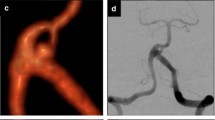Abstract
Object
The purpose of this study was to determine the incidence and outcomes of intraprocedural rupture (IPR) during endovascular coil embolization of intracranial aneurysm at a single center and to explore the technical reasons and put forward corresponding preventive measures for the feared event to serve as references for other endovascular specialists.
Methods
The aneurysm database in our series was retrospectively reviewed. From April 2005 to March 2009, 176 aneurysms were consecutively treated with coils in 161 patients and IPR occurred in 12 patients. The medical records for the 12 patients were seriously examined.
Results
Of the 12 patients (6.8 %), four were men and eight were women with a median age of 56 years. An emergency “rescue clipping” of the lesion was carried out in two patients, parent artery occlusion was performed in two cases, endovascular treatment was terminated in one case and aneurysm coiling was rapidly completed in the remaining seven cases. Complete occlusion was achieved in nine aneurysms and incomplete occlusion in one. One patient died, yielding a mortality rate of 8.3 %. The follow-up duration was 6–30 months (median 14 months) and the mean Glasgow Outcome Scale score at the last follow-up examination was 4.3.
Conclusions
The rate of IPR during endovascular coiling of intracranial aneurysms is quite low and the clinical outcome from this complication need not be catastrophic if managed appropriately. Improved operation skill and practical experience exchange among neuroradiologists are essential to lower the incidence or better patient prognoses.



Similar content being viewed by others
References
Brisman JL, Niimi Y, Song JK, Berenstein A (2008) Aneurysmal rupture during coiling: low incidence and good outcomes at a single large volume center. Neurosurgery 62(6 Suppl 3):1538–1551
Byrne JV (2006) The aneurysm “clip or coil” debate. Acta Neurochir (Wien) 148:115–120
Cloft HJ, Kallmes DF (2002) Cerebral aneurysm perforations complicating therapy with Guglielmi detachable coils: a meta-analysis. AJNR Am J Neuroradiol 23:1706–1709
Doerfler A, Wanke I, Egelhof T, Dietrich U, Asgari S, Stolke D, Forsting M (2001) Aneurysmal rupture during embolization with Guglielmi detachable coils: causes, management, and outcome. AJNR Am J Neuroradiol 22:1825–1832
Elijovich L, Higashida RT, Lawton MT, Duckwiler G, Giannotta S, Johnston SC; Cerebral Aneurysm Rerupture After Treatment (CARAT) Investigators (2008) Predictors and outcomes of intraprocedural rupture in patients treated for ruptured intracranial aneurysms: the CARAT study. Stroke 39:1501–1506
Henkes H, Fischer S, Weber W, Miloslavski E, Felber S, Brew S, Kuehne D (2004) Endovascular coil occlusion of 1811 intracranial aneurysms: early angiographic and clinical results. Neurosurgery 54:268–280
Kwon BJ, Han MH, Oh CW, Kim KH, Chang KH (2003) Procedure-related haemorrhage in embolisation of intracranial aneurysms with Guglielmi detachable coils. Neuroradiology 45:562–569
Lee JM, Kim TS, Joo SP, Yoon W, Choi HY (2010) Endovascular treatment of ruptured dissecting vertebral artery aneurysms–long-term follow-up results, benefits of early embolization, and predictors of outcome. Acta Neurochir (Wien) 152:1455–1465
Levy E, Koebbe CJ, Horowitz MB, Jungreis CA, Pride GL, Dutton K, Kassam A, Purdy PD (2001) Rupture of intracranial aneurysms during endovascular coiling: management and outcomes. Neurosurgery 49:807–811
Molyneux AJ, Kerr RS, Yu LM, Clarke M, Sneade M, Yarnold JA, Sandercock P; International Subarachnoid Aneurysm Trial (ISAT) Collaborative Group (2005) International subarachnoid aneurysm trial (ISAT) of neurosurgical clipping versus endovascular coiling in 2143 patients with ruptured intracranial aneurysms: a randomised comparison of effects on survival, dependency, seizures, rebleeding, subgroups, and aneurysm occlusion. Lancet 366:809–817
Nguyen TN, Raymond J, Guilbert F, Roy D, Bérubé MD, Mahmoud M, Weill A (2008) Association of endovascular therapy of very small ruptured aneurysms with higher rates of procedure-related rupture. J Neurosurg 108:1088–1092
Nussbaum ES, Defillo A, Janjua TM, Zelensky A, Tatman P, Stoller R, Lowary J, Nussbaum LA (2011) Emergency surgical salvage for severe intracranial aneurysm rupture during endovascular coiling procedures not amenable to additional coiling. Surg Neurol Int 2:87
Park HK, Horowitz M, Jungreis C, Genevro J, Koebbe C, Levy E, Kassam A (2005) Periprocedural morbidity and mortality associated with endovascular treatment of intracranial aneurysms. AJNR Am J Neuroradiol 26:506–514
Peltier J, Nowtash A, Toussaint P, Desenclos C, Deramond H, Le Gars D (2004) Aneurysmal rupture during embolization with Guglielmi detachable coils [in French]. Neurochirurgie 50:454–460
Ross IB, Dhillon GS (2005) Complications of endovascular treatment of cerebral aneurysms. Surg Neurol 64:12–18
Sluzewski M, Bosch JA, van Rooij WJ, Nijssen PC, Wijnalda D (2001) Rupture of intracranial aneurysms during treatment with Guglielmi detachable coils: incidence, outcome, and risk factors. J Neurosurg 94:238–240
Sluzewski M, van Rooij WJ, Beute GN, Nijssen PC (2005) Late rebleeding of ruptured intracranial aneurysms treated with detachable coils. AJNR Am J Neuroradiol 26:2542–2549
Tummala RP, Chu RM, Madison MT, Myers M, Tubman D, Nussbaum ES (2001) Outcomes after aneurysm rupture during endovascular coil embolization. Neurosurgery 49:1059–1066
van Rooij WJ, Sluzewski M, Beute GN, Nijssen PC (2006) Procedural complications of coiling of ruptured intracranial aneurysms: incidence and risk factors in a consecutive series of 681 patients. AJNR Am J Neuroradiol 27:1498–1501
Conflicts of interest
None.
Author information
Authors and Affiliations
Corresponding author
Rights and permissions
About this article
Cite this article
Zhang, Y., Li, G., Cai, Y. et al. Rupture during the endovascular treatment of intracranial aneurysms: outcomes and technical aspects. Acta Neurochir 155, 569–577 (2013). https://doi.org/10.1007/s00701-013-1628-x
Received:
Accepted:
Published:
Issue Date:
DOI: https://doi.org/10.1007/s00701-013-1628-x




